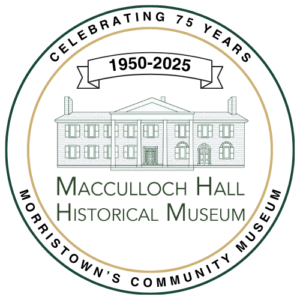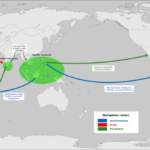Attorney General Keasbey visited the Macculloch’s in the summer of 1846. In the account he wrote of his stay, he recalls performing “the feat of grating a whole cocoanut” during a meal in the garden. At this point in time, coconuts would not have been easy to acquire. Yet, Keasbey’s account and Mrs. Macculloch’s cookbook tell us that the Macculloch’s did, in fact, have access to them (https://maccullochhall.org/activity/munchie-monday-coconut-jumbals/).
To better understand how coconuts arrived in the New World, it is necessary to look far back into their history. As a result of their long relationship with humans, the origin of coconuts is slightly unclear. However, it is most likely that they originated in the Indo-Malay region. Recent DNA analysis suggests that there are two distinct types of coconut: the Pacific coconut and the Indian Ocean coconut. Evidence from this analysis suggests that Pacific coconuts were introduced into the Indian Ocean by the Austronesians several thousand years ago as they established new trade routes. In turn, cultivation in the Indian Ocean Basin resulted in genetically different coconuts.
With this information it is possible to trace human migration and trade dating back hundreds of years. In the New World, for example, coconuts are, for the most part, of the Indian Ocean variety. The Portuguese brought coconuts from the Indian Ocean basin to the West Coast of Africa and from there they brought them to the Caribbean and Brazil. However, Pacific coconuts can also be found on the West Coast. During the colonial period, the Spanish brought over Pacific coconuts to Mexico from the Philippines. There is even some additional evidence that suggests that the Ancient Austronesians brought the Pacific variety to some islands in the New World during the pre-Columbian period.
As can be seen, there was a deliberate effort to transport and grow coconuts in the New World. However, while most of this transport was intentional, not all of it was. In fact, on January 9, 1878, the Spanish ship known as the Providencia sank while carrying coconuts from Cuba to Spain. The cargo then washed ashore on the Florida coast and locals planted them. This area would later come to be known as Palm Beach County as a result of all the coconut palms that grew there.
As a whole, the coconut trade grew rather quickly. Despite already being grown in the Americas by the mid-1800s, the trade of coconuts did not truly begin until the mid-18th century. By the 1760s, European explorers realized that coconuts were particularly well suited for sea travel. Not only could they be used as food, but they kept water fresh inside their shells and could also be used as an antidote for scurvy. From this point on, the coconut trade began to expand.
For the first century or so that the coconut trade existed, indigenous people were able to maintain some level of control over the coconut trade for a time. If Euro-American traders behaved in a way that went against social mores, indigenous people simply refused to trade with them, creating an incentive for greater cooperation. By the mid to late-19th century, however, European and American traders began to gain tighter control of the coconut trade. Trading houses started to pop up in the 1850s and by the 1880s Europeans were establishing coconut plantations. While slavery no longer legally existed at this point, the Samoan paramount chief Mata’afa described the labor done by native Samoans on European owned plantations as “slave-like.” On top of this, plantations also became a means to westernize native populations and undermine indigenous traditions.
Despite European control, indigenous people in the Pacific did retain some autonomy. In Samoa, for example, many Samoans simply refused to work on plantations. Instead of working for wages, they continued to practice subsistence farming. In turn, this allowed them to have greater control over their lives and also allowed them to control large portions of land where coconut palms grew. When Samoans did work for wages, they demanded to be paid the same amount as Europeans.
In many ways, the story of the coconut is similar to many other foods adopted by Western markets. The coconut trade put increased pressure on indigenous people to conform to European economic standards and market demand. At the same time however, the story of the coconut differs in that, despite being an in-demand product, indigenous people were able to maintain some control over the product. Despite European attempts to grow coconuts in other parts of the world and establish plantations in the Pacific, their attempts were only mildly successful and, to this day, coconut production remains concentrated in South East Asia.
Resources:
This article that gives an overview of coconuts journey from South East Asia to the Middle East and Africa
Sources referenced:
- academic-eb-com.proxygw.wrlc.org/levels/collegiate/article/coconut/24606
- https://blogs.scientificamerican.com/thoughtomics/httpblogsscientificamericancomthoughtomics20110801coconuts-not-indigenous-but-quite-at-home-nevertheless/
- https://source.wustl.edu/2011/06/deep-history-of-coconuts-decoded/
- http://proxygw.wrlc.org/login?url=http://search.ebscohost.com/login.aspx?direct=true&db=30h&AN=133508852&site=ehost-live
- http://proxygw.wrlc.org/login?url=http://search.ebscohost.com/login.aspx?direct=true&db=30h&AN=133508848&site=ehost-live
- http://proxygw.wrlc.org/login?url=http://search.ebscohost.com/login.aspx?direct=true&db=30h&AN=133508849&site=ehost-live
- New Jersey Generations: Macculloch Hall, Morristown by John Brett Langstaff

Topic: Munchie Monday
Age / Level: Life Long Learner


